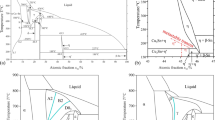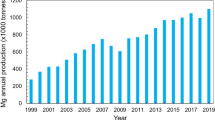Abstract
The microstructure and the mechanical properties of the submicrovolumes in the rare-earth magnets KS25 sintered from a Co–25% Sm alloy is studied. The microstructure is studied by optical, electron, and atomic force microscopy. The microstructure is found to be characterized by the presence of SmCo5 dendrites, the interdendritic space consisting of a mixture of the SmCo5 and Sm2Co17 phases, individual Sm2Co17-phase grains, Zr5Co3FeSm compound crystals (1–5 μm in size), and globular Sm2O3 samarium oxide inclusions (2–10 μm in size). The hardness H (GPa) and Young’s modulus E (GPa) of the main Sm2Co17 and SmCo5 phases are determined by nanoindentation. The machinability of the magnets is estimated using the nanoindentation data; the additional pressure and adhesion at the boundary of the Sm2Co17 and SmCo5 phases are calculated. The calculation shows that the additional pressure exceeds the external pressure by a factor of 300, and the adhesion of the phases (Kint = 0.543 MPa m0.5) is lower than that of the strengthening coatings by an order of magnitude. This finding can be the cause of magnet cracking along the boundary between the Sm2Co17 and SmCo5 phases during cutting and grinding.



Similar content being viewed by others
Notes
In [4], the microhardness units (N/mm2) are physically correct; however, in recent decades, MPa is used as the unit of measurement (1 N/mm2 ≈ 1 MPa and 1 N/m2 ≈ 1 Pa.
REFERENCES
A. B. Al’tman, A. N. Gerberg, P. A. Gladyshev, et al., Permanent Magnets: Handbook, Ed. by Yu. M. Pyatin (Energiya, Moscow, 1980).
C.-B. Jiang and S.-Z. An, “Recent progress in high temperature permanent magnetic materials,” Rare Metals 32 (5), 431–440 (2013).
O. Gutfleisch, M. A. Willard, E. Brück, C. H. Chen, S. G. Sankar, and J. P. Liu, “Magnetic materials and devices for the 21st century: Stronger, lighter, and more energy efficient,” Advanced Mater. 23 (7), 821–842 (2011).
G. P. Stanolevich, N. V. Fedoseev, S. A. Timakov, and S. L. Borisov, “Stability of rare-earth metals to impact load,” Vopr. Elektromekh. 139, 35–43 (2014).
P. I. Victoria, W. Yin, S. K. Gupta, and S. Constantinides, “Microstructural characteristics of Sm–Co magnets,” in Proceedings of ASME International Mechanical Engineering Congress and Exposition (2014), Vol. 14, p. 111737.
L. Ren, G. C. Hadjipanayis, and A. Parvizi-Majidi, “Fracture toughness and flexural strength of Sm(Co,Fe,Cu,Zr)7–8 magnetic alloys,” J. Magn. Magn. Mater. 257 (1), 58–68 (2003).
W. Li, A. H. Li, H. J. Wang, W. Pan, and H. W. Chang, “Study of strengthening and toughening of sintered rare-earth permanent magnets,” J. Appl. Phys. 105 (7), 07A703 (2009).
State Standard GOST 21559-76. Materials Hard Magnetic Sintered. Grades (Izd. Standartov, Moscow, 1976).
Z. Xue, Z. Liu, L. Liu, M. Li, S. He, D. Lee, Y. Guo, and A. Yan, “Anisotropy of mechanical properties of Sm–Co permanent magnets doped with dysprosium,” in INTERMAG2015: IEEE Intern. Magnet. Conf., Beijing (2015), p. 7156519.
Yu. I. Golovin, “Nanoindentation and mechanical properties of materials in nanoscale (review),” Fiz. Tverd. Tela 50 (12), 2113–2142 (2008).
W. C. Oliver and G. M. Pharr, “An improved technique for determining hardness and elastic modulus using load and displacement sensing indentation experiments”, J. Mater. Res. 7 (6), 1564–1583 (1992).
State Standard GOST R 8.748–2011. GSI. Metals and Alloys. Measurement of Hardness and Other Characteristics of Materials upon Instrumental Indentation. Part 1. Testing Procedure (Standartinfrom, Moscow, 2013).
Nanohardness Testers NanoSkan-4D. Specification. TU 4271-049-48786949–2014 (NUMK.421452.002 TU).
O. A. Chikova, E. V. Shishkina, A. N. Petrova, and I. G. Brodova, “Measuring the nanohardness of commercial submicrocrystalline aluminum alloys produced by dynamic pressing,” Phys. Met. Metallogr. 115 (5), 523–528 (2014).
O. A. Chikova, P. L. Reznik and B. V. Ovsyannikov, “Structure and nanomechanical characteristics of Al–Cu–Mg–Si alloy with partly liquated grain boundaries upon heat treatment,” Phys. Met. Metallogr. 117 (12), 1245–1250 (2016).
O. A. Chikova, E. V. Shishkina, A. N. Petrova, and I. G. Brodova, “Determination of Young’s modulus by nanoindentation of submicrocrystalline V95 and AMts alloys fabricated by dynamic pressing,” Deform. Razrushenie Mater., No. 8, 43–48 (2013).
D. M. Herlach, J. Gao, D. Holland-Moritz, and T. Volkmann, “Nucleation and phase-selection in undercooled melts,” Mater. Sci. Eng. 375–377, 9–15 (2004).
N. I. Muskhelishvili, Some Principal Tasks of Mathematical Theory of Elasticity (Nauka, Moscow, 1966).
C. Zhang, H. Zhou, and L. Liu, “Laminar Fe-based amorphous composite coatings with enhanced bonding strength and impact resistance,” Acta Mater. 72, 239–251 (2014).
S. A. Firstov, V. F. Gorban, and E. P. Pechkovskii, “Measurement of ultimate value of hardness, elastic strain and stress of materials by an automatic indentation method,” Materialoved., No. 8, 15–21 (2008).
ACKNOWLEDGMENTS
This study was performed using equipment of the Ural Collective Use C-enter for Modern Nanotechnologies in the Institute of Natural Sciences and Mathematics of the Ural Federal University Named after the First President of Russia B.N. Yeltsin.
Author information
Authors and Affiliations
Corresponding author
Additional information
Translated by N. Kolchugina
Rights and permissions
About this article
Cite this article
Chikova, O.A., Slinkin, I.V. & V’yukhin, V.V. Structure and Mechanical Properties in the Submicrovolumes of Sintered KS25 (Co–Sm) Permanent Magnets. Russ. Metall. 2020, 225–230 (2020). https://doi.org/10.1134/S0036029520030040
Received:
Revised:
Accepted:
Published:
Issue Date:
DOI: https://doi.org/10.1134/S0036029520030040




